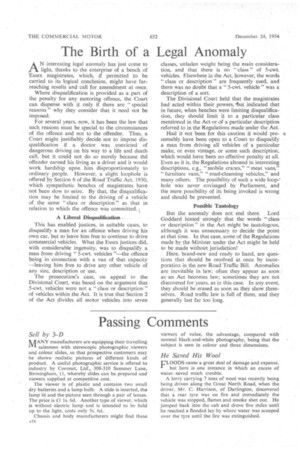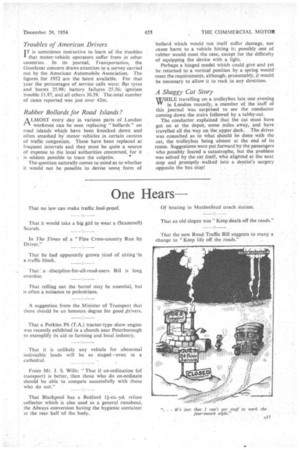Passing Comments
Page 18

Page 19

If you've noticed an error in this article please click here to report it so we can fix it.
Sell by 3-D
MANY manufacturers are equipping their travelling salesmen with sterescopic photographic viewers and colour slides, so that prospective customers may be shown realistic pictures of different kinds of product. A useful photographic service is offered to industry by Coronet, Ltd, 308-310 Summer Lane, Birmingham, 11, whereby slides can be prepared and viewers supplied at competitive cost.
The viewer is of plastic and contains two small dry batteries and a lamp bulb. A slide is inserted, the lamp lit and the picture seen through a pair of lenses: The price is £1 ls. 6d. Another type of viewer, which is without electric lamp and is intended to be held up to the light, costs only 5s. 6d.
Chassis and body manufacturers might find these viewers of value, the advantage, compared with normal black-and-white photography, being that the subject is seen in colour and three dimensions.
Be Saved His Wool
FLOODS cause a great deal of damage and expense, but here is one instance in Which an excess of water.. saved much. trouble.
A lorry carrying 7 tons of wool was recently being being driven along the Great North Road, when the driver, Mr. C. Harrison, of Darlington, discovered that a rear tyre was on fire and immediately the vehicle was stopped, flames and smoke shot out. He jumped back into the cab and drove five miles until he reached a flooded lay-by where water was scooped over the tyre until the fire was extinguished.
Troubles of American Drivers
IT is sometimes instructive to learn of the troubles I that motor-vehicle operators suffer from in other countries. In its journal, Transportation, the Goodyear concern draws attention to a survey carried out by the American Automobile Association. The figures for 1952 are the latest available. For that year the percentages of service calls were: flat tyres and bursts 25.98; battery failures 25.56; ignition trouble 11.87, and all others 36.59. The,totaI number of cases reported was just over 42m.
Rubber Bollards for Road Islands?
ALMOST every day in various parts of London
workmen can be seen replacing " bollards " on road islands which have been knocked down and often smashed by motor vehicles in certain centres of traffic congestion. These have been replaced at frequent intervals and they must be quite a source of expense to the local authorities concerned, for it
is seldom possible to trace the culprits. S The question naturally comes to mind as to whether it would not be possible to devise some form of bollard which would not itself suffer damage, nor cause harm to a vehicle hitting it; possibly one of rubber would meet the case, except for the difficulty of equipping the device with a light.
Perhaps a hinged model which could give and yet be returned to a vertical position by a spring would meet the requirements, although, presumably, it would be necessary to allow it to rock in any direction.
A Shaggy Cat Story
WHILE travelling on a trolley bus late one evening YV in London recently, a member of the staff of this journal was surprised to see the conductor coming down the stairs followed by a tabby-cat. The conductor explained that the cat must have got on at the depot, some miles away, and have travelled all the way on the .upper deck. The driver was consulted as to what should be done with the cat, the trolleybus being almost at the end of its route. Suggestions were put forward by the passengers who possibly feared a catastrophe, but the problem was solved by the cat itself, who alight-ed at the next stop and promptly walked into a dentist's surgery opposite the bus stop!












































































